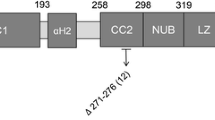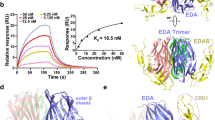Abstract
Purpose
Anhidrotic ectodermal dysplasia with immunodeficiency (EDA-ID) is characterized by hypohidrosis, dental abnormalities, sparse hair, and immunodeficiency. Autosomal dominant (AD)-EDA-ID, caused by a heterozygous mutation within NFKBIA, is very rare and its clinical features remain largely unknown. This study describes a patient with AD-EDA-ID harboring a novel NFKBIA mutation who presented with mild EDA and non-infectious systemic inflammation.
Methods
The clinical presentation of an AD-EDA-ID patient was described and immunological, genetic, and biochemical analyses were performed, with a focus on nuclear factor kappa B (NF-κB) activation.
Results
The patient presented with symptoms of mild EDA-ID, namely sparse hair and hypohidrosis, although a skin biopsy confirmed the presence of sweat glands. There were no dental abnormalities. The patient also suffered from non-infectious inflammation, which responded to systemic corticosteroid therapy; however, the patient remained ill. Immunological analyses revealed reduced Toll-like receptor/IL-1 (TLR/IL-1) and tumor necrosis factor (TNF) receptor family responses to various stimuli. Genetic analysis identified a de novo heterozygous missense mutation, p.Ser36Tyr, in NFKBIA, resulting in defective NFKBIA degradation and impaired NF-κB activation. The patient was diagnosed with AD-EDA-ID and underwent hematopoietic stem cell transplantation. Engraftment was successful, with few signs of acute graft versus host disease. However, the patient suffered hemolytic anemia and thrombocytopenia, and died from a brain hemorrhage due to intractable thrombocytopenia.
Conclusion
AD-EDA-ID patients can present with mild ectodermal dysplasia and non-infectious inflammation, rather than with recurrent infections. Also, hematopoietic stem cell transplantation for AD-EDA-ID is still a clinical challenge.







Similar content being viewed by others
References
Vallabhapurapu S, Karin M. Regulation and function of NF-kappaB transcription factors in the immune system. Annu Rev Immunol. 2009;27:693–733. doi:10.1146/annurev.immunol.021908.132641.
Karin M, Ben-Neriah Y. Phosphorylation meets ubiquitination: the control of NF-[kappa]B activity. Annu Rev Immunol. 2000;18:621–63. doi:10.1146/annurev.immunol.18.1.621.
Brown K, Gerstberger S, Carlson L, Franzoso G, Siebenlist U. Control of I kappa B-alpha proteolysis by site-specific, signal-induced phosphorylation. Science. 1995;267(5203):1485–8.
Traenckner EB, Pahl HL, Henkel T, Schmidt KN, Wilk S, Baeuerle PA. Phosphorylation of human I kappa B-alpha on serines 32 and 36 controls I kappa B-alpha proteolysis and NF-kappa B activation in response to diverse stimuli. EMBO J. 1995;14(12):2876–83.
Jain A, Ma CA, Liu S, Brown M, Cohen J, Strober W. Specific missense mutations in NEMO result in hyper-IgM syndrome with hypohydrotic ectodermal dysplasia. Nat Immunol. 2001;2(3):223–8. doi:10.1038/85277.
Doffinger R, Smahi A, Bessia C, Geissmann F, Feinberg J, Durandy A, et al. X-linked anhidrotic ectodermal dysplasia with immunodeficiency is caused by impaired NF-kappaB signaling. Nat Genet. 2001;27(3):277–85. doi:10.1038/85837.
Zonana J, Elder ME, Schneider LC, Orlow SJ, Moss C, Golabi M, et al. A novel X-linked disorder of immune deficiency and hypohidrotic ectodermal dysplasia is allelic to incontinentia pigmenti and due to mutations in IKK-gamma (NEMO). Am J Hum Genet. 2000;67(6):1555–62. doi:10.1086/316914.
Courtois G, Smahi A, Reichenbach J, Doffinger R, Cancrini C, Bonnet M, et al. A hypermorphic IkappaBalpha mutation is associated with autosomal dominant anhidrotic ectodermal dysplasia and T cell immunodeficiency. J Clin Invest. 2003;112(7):1108–15. doi:10.1172/JCI18714.
Hanson EP, Monaco-Shawver L, Solt LA, Madge LA, Banerjee PP, May MJ, et al. Hypomorphic nuclear factor-kappaB essential modulator mutation database and reconstitution system identifies phenotypic and immunologic diversity. J Allergy Clin Immunol. 2008;122(6):1169 e16–77 e16. doi:10.1016/j.jaci.2008.08.018.
Ohnishi H, Miyata R, Suzuki T, Nose T, Kubota K, Kato Z, et al. A rapid screening method to detect autosomal-dominant ectodermal dysplasia with immune deficiency syndrome. The Journal of allergy and clinical immunology. 2012;129(2):578–80. doi:10.1016/j.jaci.2011.09.042.
Lopez-Granados E, Keenan JE, Kinney MC, Leo H, Jain N, Ma CA, et al. A novel mutation in NFKBIA/IKBA results in a degradation-resistant N-truncated protein and is associated with ectodermal dysplasia with immunodeficiency. Hum Mutat. 2008;29(6):861–8. doi:10.1002/humu.20740.
McDonald DR, Mooster JL, Reddy M, Bawle E, Secord E, Geha RS. Heterozygous N-terminal deletion of IkappaBalpha results in functional nuclear factor kappaB haploinsufficiency, ectodermal dysplasia, and immune deficiency. The Journal of allergy and clinical immunology. 2007;120(4):900–7. doi:10.1016/j.jaci.2007.08.035.
Janssen R, van Wengen A, Hoeve MA, ten Dam M, van der Burg M, van Dongen J, et al. The same IkappaBalpha mutation in two related individuals leads to completely different clinical syndromes. J Exp Med. 2004;200(5):559–68. doi:10.1084/jem.20040773.
Nishikomori R, Akutagawa H, Maruyama K, Nakata-Hizume M, Ohmori K, Mizuno K, et al. X-linked ectodermal dysplasia and immunodeficiency caused by reversion mosaicism of NEMO reveals a critical role for NEMO in human T-cell development and/or survival. Blood. 2004;103(12):4565–72. doi:10.1182/blood-2003-10-3655.
Kawai T, Nishikomori R, Izawa K, Murata Y, Tanaka N, Sakai H, et al. Frequent somatic mosaicism of NEMO in T cells of patients with X-linked anhidrotic ectodermal dysplasia with immunodeficiency. Blood. 2012;119(23):5458–66. doi:10.1182/blood-2011-05-354167.
Nishikori M, Maesako Y, Ueda C, Kurata M, Uchiyama T, Ohno H. High-level expression of BCL3 differentiates t(2;5)(p23;q35)-positive anaplastic large cell lymphoma from Hodgkin disease. Blood. 2003;101(7):2789–96. doi:10.1182/blood-2002-08-2464.
Fish JD, Duerst RE, Gelfand EW, Orange JS, Bunin N. Challenges in the use of allogeneic hematopoietic SCT for ectodermal dysplasia with immune deficiency. Bone Marrow Transplant. 2009;43(3):217–21. doi:10.1038/bmt.2008.308.
Dupuis-Girod S, Cancrini C, Le Deist F, Palma P, Bodemer C, Puel A, et al. Successful allogeneic hemopoietic stem cell transplantation in a child who had anhidrotic ectodermal dysplasia with immunodeficiency. Pediatrics. 2006;118(1):e205–11. doi:10.1542/peds.2005-2661.
Permaul P, Narla A, Hornick JL, Pai SY. Allogeneic hematopoietic stem cell transplantation for X-linked ectodermal dysplasia and immunodeficiency: case report and review of outcomes. Immunol Res. 2009;44(1–3):89–98. doi:10.1007/s12026-008-8085-2.
Acknowledgments
We thank Takeda Pharmaceutical Inc. for kindly providing us with recombinant human IL-2. We also thank Dr. Jain for providing the recombinant human soluble CD40L and Dr. Utani for providing us with normal fibroblasts. We would like to thank Dr. Momoko Nishikori for help with the EMSA assay. This work was supported by Japan’s Ministry of Health, Labor and Welfare and Japan’s Ministry of Education, Culture, Sports, Science, and Technology.
Conflict of Interest
The authors report no actual or potential conflicts of interest.
Author information
Authors and Affiliations
Corresponding author
Rights and permissions
About this article
Cite this article
Yoshioka, T., Nishikomori, R., Hara, J. et al. Autosomal Dominant Anhidrotic Ectodermal Dysplasia with Immunodeficiency Caused by a Novel NFKBIA Mutation, p.Ser36Tyr, Presents with Mild Ectodermal Dysplasia and Non-Infectious Systemic Inflammation. J Clin Immunol 33, 1165–1174 (2013). https://doi.org/10.1007/s10875-013-9924-z
Received:
Accepted:
Published:
Issue Date:
DOI: https://doi.org/10.1007/s10875-013-9924-z




